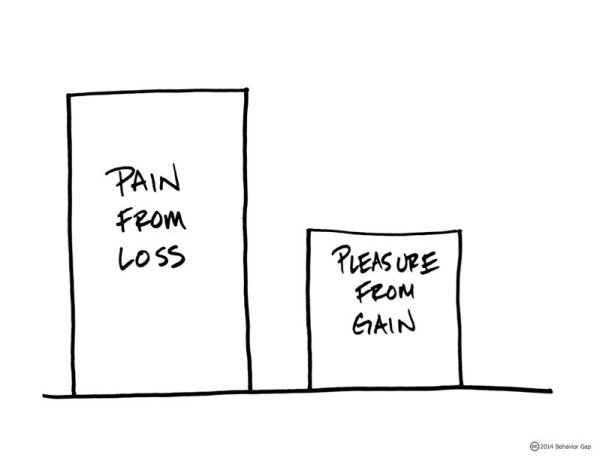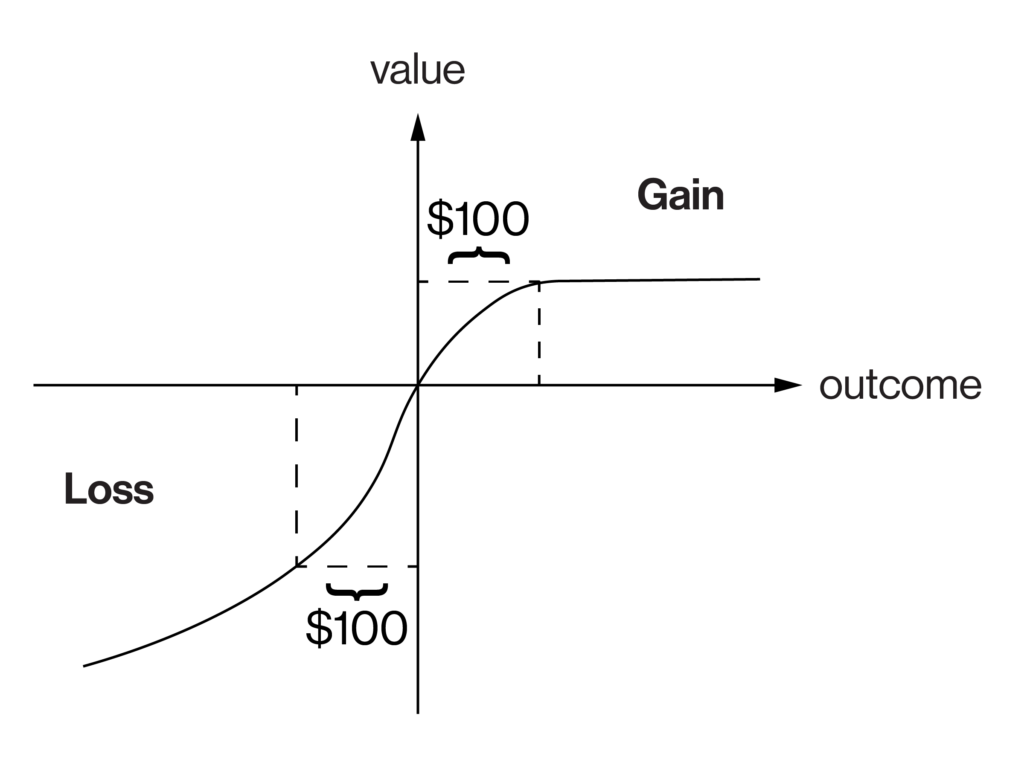This article is an excerpt from ‘Loyalty Programs: The Complete Guide‘. Buy it now on Amazon at at all leading book stores.

Loss aversion suggests that the pain of losing something feels twice as powerful as the pleasure of gaining the same thing.
Kahneman and Tversky (1979)[1] conducted a series of experiments where subjects were asked to choose between more or less risky propositions which provided the potential to win or lose money (e.g., an equal chance of winning or losing $100). They found ‘the aggravation that one experiences in losing a sum of money appears to be greater than the pleasure associated with gaining the same amount’, and that most people find symmetric bets of that form to be distinctly unattractive.

The findings by Kahneman and Tversky, showing the fear of losing $100 is twice as powerful as the prospect of gaining $100. Adapted from ‘Prospect Theory: An Analysis of Decision under Risk’, D Kahneman and A Tversky 1979.[2]
These findings have led to the development of strategies whereby workers and students have been motivated by penalties rather than rewards. Hossain & List (2012)[3] determined that framing outcomes as penalties resulted in improved performance in a Chinese production factory. Fryer et al (2012)[4] demonstrated that exploiting the power of loss aversion, where teachers were paid in advance and asked to give back the money if their students did not improve sufficiently, increased math test scores by more than one standard deviation.
People appear to be more willing to take risks or behave dishonestly to avoid a loss than to make a gain. A study by Schindler & Pfattheicher (2016)[5] used a die-under-the-cup game and a coin-toss task, with the opportunity for participants to engage in dishonest behaviour either to avoid a loss or to approach an equivalent gain. Their results found that people showed more dishonest behaviour to avoid a loss.
Loss aversion is used extensively in loyalty programs (and marketing strategies more widely) to stimulate member engagement. Programs can provide members with something which they feel ownership for and value, and then establish conditions whereby they might have ownership removed. This can act as a motivational force to compel the member to continue transacting. This includes:
- The threat of status tier members losing their benefits if they fail to earn enough status credits.
- Members facing the risk of their points expiring if they do not engage with the program on a regular enough basis (or redeem them in time).
- Members not being able to access desirable rewards (reward seats, hotel rooms, etc.).
- Members having to spend a greater amount of points if they do not book early enough.
According to Ries (2012),[6] some private fitness centres allow people to invest their own money in weight-loss incentives (e.g. by putting in $200 and receiving a portion back as they achieve incremental weight-loss goals). Websites like www.stickK.com operate on the same basis in the online environment. They help people achieve goals via a ‘commitment contract’; a binding agreement which involves putting money on the table to ensure the user follows through with their intentions using loss aversion.
Loyalty programs also build in benefits which minimise the risk of loss aversion. For example, offering members money back guarantees, extended returns, free returns or automatic refunds if prices reduce on purchased items. These program benefits can provide the member with an extra sense of security by lowering the perceived risk of losing money.
| Example: Mileage Runs A ‘mileage run’ or ‘status run’ involves members of a frequent flyer program taking a flight with the sole purpose of earning enough status credits to ensure their status tier is maintained. The destination or the number of frequent flyer points earned for the trip can be secondary considerations. If a member has not flown enough in a calendar year to qualify or re-qualify for a premium status, sometimes they will engage in a mileage or status run due to the high value placed on the benefits they stand to lose. Many websites and forums exist for frequent flyer members to research or discuss how a member can book a flight with the necessary status credits for the lowest cost. For example, one forum, Flyertalk, has 13,508 threads related to mileage run discussions.[7] After recognising the patterns of mileage runners, airlines may adjust their promotions by offering more frequent status credit promotions on certain routes rather than offering sale prices (i.e. double status credits). |
[1] Kahneman, D. & Tversky, A., 1979, ‘Prospect Theory: An Analysis of Decision under Risk’, Econometrica, Vol. 47, Iss 2, pp263-9.
[2] Ibid.
[3] Hossain, T. & List, J., 2009, ‘The Behavioralist Visits the Factory: Increasing Productivity Using Simple Framing Manipulations’, National Bureau of Economic Research, Inc, NBER Working Papers, Vol 58, Iss 12, pp2151-2167.
[4] Fryer, R. G., Levitt, S. D., List, J. & Sadoff, S., 2012. ‘Enhancing the Efficacy of Teacher Incentives through Loss Aversion: A Field Experiment,’ NBER Working Papers 18237, National Bureau of Economic Research, Inc.
[5] Schindler, S. & Pfattheicher, S., 2017, ‘The frame of the game: Loss-framing increases dishonest behavior’, Journal of Experimental Social Psychology, Vol 69, pp172-177.
[6] Ries, N. M., 2012, ‘Financial incentives for weight loss and healthy behaviours. Healthcare policy = Politiques de sante’, Vol 7, Iss 3, pp23–28.
[7] Flyertalk, https://www.flyertalk.com/forum/mileage-run-discussion-627/, accessed 18 June 2020.

